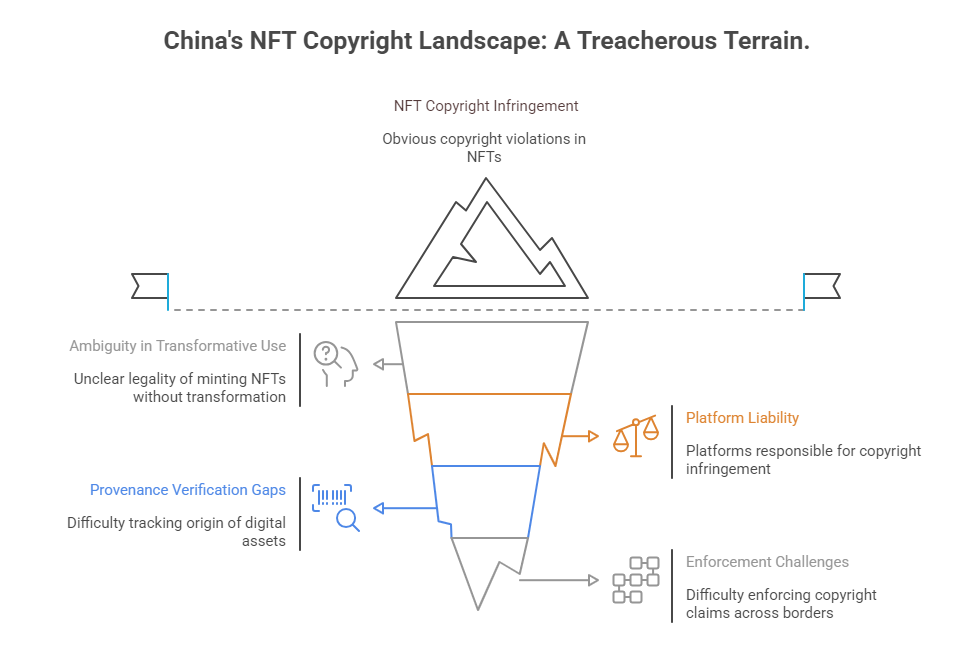China’s digital collectibles (NFT) market exploded with promise, offering artists new revenue streams and collectors unique digital assets. Yet, beneath the surface lies a complex copyright landscape fraught with legal ambiguities and compliance risks. For overseas platforms, artists, and investors navigating this space, understanding and verifying copyright ownership isn’t just best practice—it’s essential for survival.

Why China’s NFT Copyright Landscape is Treacherous
Unlike some Western jurisdictions with established NFT case law, China’s regulatory framework is evolving rapidly. Key challenges include:
- Ambiguity in “Transformative Use”: While Chinese copyright law protects original works, the legality of minting NFTs based on existing artworks, music, or cultural relics without explicit transformation (creating significant new expression) remains contested. Platforms often lack clear policies or verification mechanisms for assessing sufficient transformation.
- Platform Liability: Chinese authorities hold platforms primarily responsible for copyright infringement occurring on their services. The E-Commerce Law and Copyright Law mandate platforms to implement robust “notice-and-takedown” mechanisms and proactively prevent known infringements. Failure can lead to hefty fines, orders to cease operations, and reputational damage. The 2022 Hangzhou Internet Court ruling against a major platform for selling an infringing NFT artwork underscored this liability risk.
- Provenance Verification Gaps: Tracking the true origin of digital assets, especially those derived from traditional art or historical works, is incredibly difficult. Verifying the legitimacy of the minter’s rights (creator, authorized licensee, or rightful owner of the underlying physical asset) requires meticulous due diligence often beyond standard platform KYC checks. High-profile disputes, like those involving unauthorized minting of famous artists’ works, highlight this vulnerability.
- Enforcement Challenges: While blockchain offers immutability for the NFT itself, enforcing copyright claims against anonymous or pseudonymous infringers across borders remains difficult. Identifying the real-world entity behind a wallet and pursuing legal action can be costly and time-consuming.
Core Compliance Checks for NFT Platforms & Participants
To mitigate these substantial risks, rigorous verification is non-negotiable. Here are the essential checks platforms must perform, and that artists/collectors should demand:
- Direct Creator Verification:
- Identity Confirmation: Rigorous KYC processes verifying the minter’s real-world identity (individual or legal entity) using government-issued IDs and business registration documents.
- Proof of Authorship/Creation: Requiring evidence demonstrating the minter created the original work (e.g., original source files with timestamps, drafts, creation process documentation). For collaborative works, proof of rights allocation agreements is critical.
- Platform Authentication: Implementing verified artist/brand programs with stringent application reviews based on documented proof.
- Licensor Verification (For Derivative Works or Licensed Content):
- Valid License Agreement Scrutiny: Obtaining and meticulously reviewing the original license agreement between the minter and the original rights holder. This must explicitly grant the rights necessary to mint and sell the NFT (including scope, territory, duration, and sublicensing permissions).
- Licensor Rights Verification: Confirming the licensor is indeed the legitimate rights holder of the underlying work. This involves checking copyright registration certificates (where applicable) and potentially tracing the chain of title.
- Due Diligence on Licensor: Basic checks on the licensor’s legitimacy and reputation.
- Underlying Asset Verification (For Asset-Backed NFTs):
- Proof of Ownership: Requiring irrefutable proof that the minter owns the physical asset (e.g., artwork, collectible) or the exclusive rights to digitize and tokenize it (e.g., for cultural relics, often involving complex permissions).
- Authenticity Verification: Ensuring the physical asset is genuine, potentially requiring third-party appraisal reports or provenance history.
- Clear Rights Agreement: A legally binding agreement defining the rights conveyed by the NFT relative to the physical asset (e.g., ownership remains with the physical holder, the NFT represents a digital twin with specific usage rights).
- Verification of Platform Licensing (If Platform Mints): If the platform itself mints NFTs (e.g., partnerships with museums, brands), it must undergo the same level of due diligence on its own licensing rights as it expects from third-party minters. Transparency about these rights is crucial.
The Critical Role of Official Copyright Searches & Due Diligence
Relying solely on a minter’s claims is a recipe for disaster. Independent verification is paramount:
- Official Copyright Registry Checks: Searching China’s National Copyright Administration (NCAC) Copyright Registration Database is a fundamental step. While registration isn’t mandatory for copyright protection in China, it provides strong prima facie evidence of ownership and the work’s existence at a specific time. Verifying the registered owner matches the minter/licensor is essential. Our comprehensive Intellectual Property Verification Services streamline this critical process, accessing authoritative databases to confirm ownership and registration status.
- Chain of Title Analysis: For works with complex histories (e.g., inherited copyrights, assigned rights), tracing the ownership history through contracts, assignments, and inheritance documents is necessary to confirm the current claimant’s legitimacy.
- Trademark & Design Patent Checks: Especially for NFTs involving brand logos, characters, or distinctive product designs, searches in the China National Intellectual Property Administration (CNIPA) trademark and design patent databases are vital to avoid infringing others’ exclusive rights.
- Legal Opinion: For high-value NFTs or complex rights scenarios (e.g., cultural heritage, film/TV derivatives), obtaining a legal opinion from qualified Chinese IP counsel on the legitimacy of the rights being minted provides significant risk mitigation.
Beyond Verification: Building a Compliant Ecosystem
Verification is the foundation, but ongoing compliance requires more:
- Robust Takedown Mechanisms: Implementing efficient, responsive, and transparent DMCA-style procedures compliant with Chinese law.
- Clear Terms of Service: Explicitly outlining platform responsibilities, minter warranties regarding rights, infringement consequences, and dispute resolution processes.
- Proactive Monitoring: Utilizing technology and human review to detect potentially infringing content, especially known protected works.
- Educating Users: Providing clear guidelines for minters on copyright requirements and for collectors on verifying provenance before purchase.
Conclusion: Vigilance is the Price of Participation
China’s NFT market holds immense potential, but its copyright landscape demands unwavering vigilance. Platforms that fail to implement rigorous, multi-layered copyright verification processes expose themselves to severe legal, financial, and operational risks. Artists and collectors must also perform their due diligence before minting or purchasing. In this environment, thorough copyright verification and official record checks aren’t just a compliance task; they are the bedrock of trust and sustainability for any player in China’s dynamic digital collectibles space. Ensuring the legitimacy of the underlying rights is the most critical step in mitigating the inherent risks of this exciting but complex frontier.
